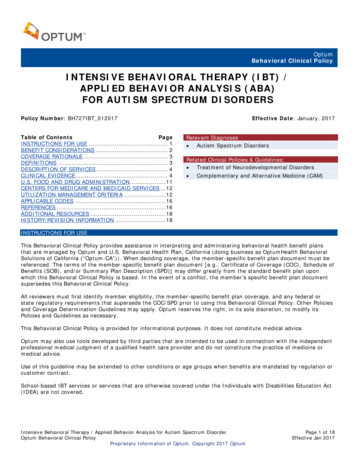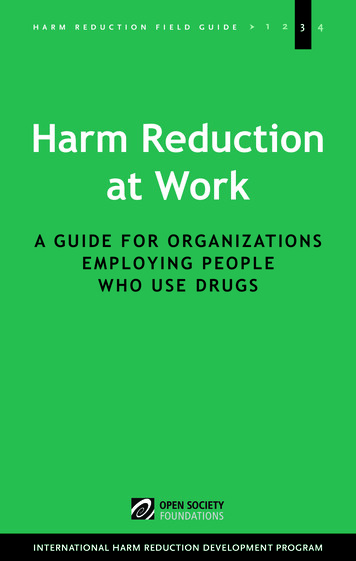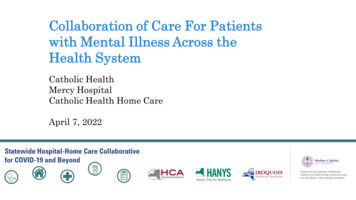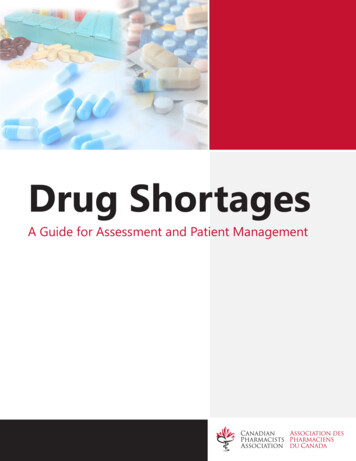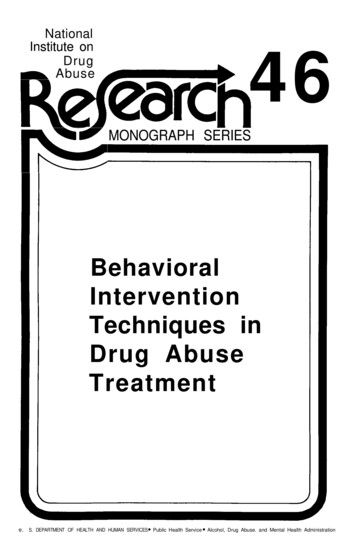
Transcription
NationalInstitute onDrugAbuse46MONOGRAPH SERIESBehavioralInterventionTechniques inDrug AbuseTreatmentU. S. DEPARTMENT OF HEALTH AND HUMAN SERVICESPublic Health ServiceAlcohol, Drug Abuse. and Mental Health Administration
Behavioral InterventionTechniques in Drug AbuseTreatmentEditors:John Grabowski, Ph.D.Division of Clinical ResearchNational Institute on Drug AbuseMaxine L. Stitzer, Ph.D.Baltimore City Hospitals, andThe Johns Hopkins Unversity School of MedicineJack E. Henningfield, Ph.D.Addiction Research CenterNational Institute on Drug AbuseNIDA Research Monograph 461984DEPARTMENT OF HEALTH AND HUMAN SERVICESPublic Health ServiceAlcohol, Drug Abuse, and Mental Health AdministrationNational Institute on Drug Abuse5600 Fishers LaneRockville, Maryland 20657For sale by the Superintendent of Documents, U.S. Government Printing: OfficeW ashington, D.C. 20402
NIDA Research Monographs are prepared by the research divisions of theNational Institute on Drug Abuse and published by its Office of Science. Theprimary objective of the series is to provide critical reviews of researchproblem areas and techniques. the content of state-of-the-art conferences, integrative research reviews and significant original research. Itsdual publication emphasis is rapid and targeted dissemination to thescientific and professional communityEditorial Advisory BoardAvram Goldstein, M.D.Addiction Research FoundationPalo Alto, CaliforniaJerome Jaffe, M.D.University of Connecticut School of MedicineFarmington, ConnecticutReese T. Jones, M.D.Langley Porter Neuropsychiatric InstituteUniversity of CaliforniaSan Francisco, CaliforniaJack Mendelson, M.D.Alcohol and Drug Abuse Research CenterHarvard Medical SchoolMcLean HospitalBelmont, MassachusettsHelen Nowlis, Ph.D.Rochester, New YorkLee Robins, Ph.D.Washington University School of MedicineSt. Louis, MissouriNIDA Research Monograph SeriesWilliam Pollin, M.D.DIRECTOR, NIDAJack Dwell, M.D.ASSOCIATE DIRECTOR, OFFICE OF SCIENCE, NIDAEDITOR-IN-CHIEFEleanor W. WaldropMANAGING EDITORParklawn Building, 5600 Fishers Lane, Rockville, Maryland 20857
Behavioral InterventionTechniques in Drug AbuseTreatment
ACKNOWLEDGMENTThis monograph is based upon papers and discussion from a technicalreview, Behavioral Intervention Techniques in Drug Abuse Treatment,held July 8 and 9, 1982, in Bethesda, Maryland, sponsored by theDivision of Research, National 'Institute on Drug Abuse.COPYRIGHT STATUSThe National Institute on Drug Abuse has obtained permission fromthe copyright holders to reproduce certain previously published'material as noted in the text. Further reproduction of thismaterial is prohibited without specific permission of the copyrightholders. All other material in this volume except quoted passagesfrom copyrighted sources is in the public domain and may be used orreproduced without permission from the Institute or the authors.Citation of the source is appreciated.Opinions expressed in this volume are those of the authors and donot necessarily reflect the opinions or official policy of theNational Institute on Drug Abuse or any other part of the U.S.Department of Health and Human Services.The U.S. Government does not endorse or favor any specificcommercial product or commodity. Trade or proprietary namesappearing in this publication are used only because they areconsidered essential in the context of the studies reported herein.Library of Congress catalog card number 83-600623DHHS publication number (ADM)84-1282Printed 1984NIDA Research Monographs are indexed in the Index Medicus. Theyare selectively included in the coverage of American StatisticsIndex, Biosciences Information Service, Chemical Abstracts, CurrentContents, Psychological Abstracts, and Psychopharmacology Abstracts.iv
ForewordKnowledge of the behavioral, environmental, and pharmacologicalcorrelates of substance use and abuse is central to the interestsof the National Institute on Drug Abuse. Thus, NIDA hascontributed to the expansion and dissemination of such knowledgeby supporting research and sponsoring major reviews to examine themechanisms that determine substance abuse and other habitualbehaviors, with particular emphasis on the common explanatoryelements. The publications that resulted from these reviews haveexplored what we know about the specific behavioralpharmacological processes which underlie the observed effects ofdrug use and abuse.Several volumes in the NIDA Research Monograph series haveembodied the perspective of behavioral pharmacology.* Withvarying emphasis, each has examined broad theoretical issues,sought to expand on and contribute to a sound conceptualframework, and applied its findings to improving the science andtechniques of treatment--in which basic research ultimately comesto fruition. Behavioral Intervention Techniques in Drug AbuseTreatment, the ninth of these monographs, focuses directly ontreatment applications as well as broader issues in the treatmentdomain.Behavioral intervention techniques are based on the premise thatbehavior is controlled by its positive and negative consequencesand can be modified by making changes in selected aspects of theenvironment so as to reinforce desired behaviors. They encompassnumerous related procedures, variously labeled as behaviormodification, behavior therapy, contingency contracting,contingency management, or token economy. These interventions areincreasingly being used, integratively with other more traditionalforms of therapy, in treating the diverse disorders associatedwith drug dependency. They can enhance the effectiveness ofessentially all available treatment components, includingpharmacological adjuncts, psychotherapy, family therapy, and jobtraining. Through such a spectrum of uses, behavioralintervention techniques, thoughtfully planned and applied, promiseincreasing levels of success in the treatment of drug abusers.v
The contributors to this monograph all are actively involved invarious aspects of drug abuse research and treatment in whichbehavioral techniques are used. Representing a broad range ofareas of expertise, their presentations will be of interest tothose who are engaged in clinical research, treatment, andanalysis of drug abuse treatment systems.William Pollin. M.D.DirectorNational Institute on Drug Abuse*Behavioral Tolerance: Research and Treatment Implications(No. 18)Self-Administration of Abused Substances: Methods for Studv(No. 20)Behavioral Analysis and Treatment of Substance Abuse (No. 25)Behavioral Pharmacology of Human Drug Dependence (No. 37)Research on Smoking Behavior (No. 17)Cigarette Smoking as a Dependence Process (No. 23)The Behavioral Aspects of Smoking (No. 26)Measurement in the Analysis and Treatment of Smoking Behavior(No. 48)vi
ContentsForewordWilliam Pollin . . . . . . . . . . . . . . . . . . . . . . .vTherapeutic Application of Behavioral Techniques: An OverviewJohn Grabowski, Maxine L. Stitzer, and Jack E. Henningfield.1Problems in Methadone Treatment: The Influence of ReferenceGroupsDana E. Hunt, Douglas S. Lipton, Douglas S. Goldsmith,and David L. Strug . . . . . . . . . . . . . . . . . . . . .8Treatment of Behavioral and Psychiatric Problems AssociatedWith Opiate DependenceGeorge E. Woody, A. Thomas McLellan, and Charles P. O'Brien. 23The Role of Behavioral Contingency Management in DrugAbuseTreatmentGeorge E. Bigelow, Maxine L. Stitzer, and Ira A. Liebson . . 36Behavioral Treatment of Drug DependenceRoy W. Pickens and Travis Thompson . . . . . . . . . . . . . 53Contingency Contracting Treatment of Drug-Abusing Physicians,Nurses, and DentistsThomas J. Crowley . . . . . . . . . . . . . . . . . . . . . 68Contingency ManagementMethadone MaintenanceMaxine L. Stitzer,and Mary E. McCaulof Supplemental Drug Use DuringTreatmentGeorge E. Bigelow, Ira A. Liebson,. . . . . . . . . . . . . . . . . . . . . 84A Contingency Analysis of Family Treatment and Drug AbuseThomas C. Todd . . . . . . . . . . . . . . . . . . . . . . . 104vii
The Job Seekers' Workshop: A Skill Training Program forDrug Treatment ClientsSharon M. Hall, Peter C. Loeb, and Tim Allen . . . . . . . . . 115Brokerage Model Rehabilitation System for Opiate Dependence:A Behavioral AnalysisTravis Thompson, Jon Koerner, and John Grabowski . . . . . . 131Behavioral Intervention Techniques in Drug Abuse Treatment:Summary of DiscussionMaxine L. Stitzer, John Grabowski, and Jack E. Henningfield. 147Contributors . . . . . . . . . . . . . . . . . . . . . . . 157List of NIDA Research Monographs . . . . . . . . . . . . . . 158viii
Therapeutic Application of Behavioral Techniques: An OverviewJohn Grabowski, Ph.D., Maxine L. Stitzer, Ph.D., andJack E. Henningfield, Ph.D.Observations on the History of TreatmentHistory is replete with examples and reports of drug abuse despitethe current popular perspective that drug abuse is a relativelyrecent behavioral anomaly. References to maladaptive patterns ofdrug use are prevalent in the treatment literature of the pastcentury, and, on even casual examination, the characteristicefforts to eliminate the problems are not unfamiliar.The techniques have ranged from essentially entirely pharmacological to completely behavioral-psychological. An early exampleof treatment in the realm of pharmacological manipulations wasthat of Bentley (1880; see Byck 1974, p. 15), who, among others,treated heroin use by administering cocaine. Later, someclinicians, researchers, and observers of the discipline didrecognize or acknowledge the importance of environmental factors."Neither cocaine nor any otherAs was noted by Bernfeld (1953),chemical, in itself, produces addiction.It is a psychologicalIn the '80s [188Os] the problem of[behavioral] phenomenon.addiction was approached, if at all, as one of toxicity specificto certain habit-forming drugs" (see Byck 1974, p. 3473.Nevertheless, despite a century of documented treatment experience, intensive research, and repetition of comments parallelingthose of Bernfeld, continued belief in the singular importance ofthe substance is frequent, and failure to acknowledge theimportance of behavioral and environmental factors in thedevelopment, maintenance, and elimination of drug use is notuncommon. Thus, for example, methadone maintenance, whenintroduced 20 years ago, constituted a pharmacological intervention which was commonly administered as a primary therapyrather than as a pharmacological adjunct to other therapy.Furthermore, this practice is not altogether unusual today.Early reports of treatment illustrated the general inadequacy ofapproaches not explicitly attending to the interactive nature ofIn the United States, "drug addiction," i.e.,drug use.1
maladaptive drug use, was for many years essentially synonymouswith use of narcotic analgesics."Treatment" for the stereotypicuser was equated, at one extreme, with inpatient drug withdrawaland discharge, and, at the other, with long-term incarceration atthe United States Public Health Service hospitals. In this case,seeming attention to the environmental factors, i.e., throughremoval from the drug-taking environment, was in fact founded in aLater, Wikler (1965) and otherspharmacological perspective.pointed to the difficulties in the model and developed atheoretical position delineating the role of some environmentalfactors in the maintenance of opiate use (e.g., Stitzer et al.1983; Grabowski and Cherek 1983). As Stitzer et al. (1983) havenoted concerning treatment based on the incarceration strategy,"the therapeutic success.was not impressive."It was, however,consistent with a general societal view which dictated thatremoval of an individual with behavioral disorders to a separateenvironment would contribute to a return to health or provide anopportunity for rehabilitation. As with the mentally ill andmentally retarded individuals of an earlier era (e.g., seeThompson and Grabowski 1977; Deutsch 1949). it has since becomeclear that temporary, or even prolonged, removal from the naturalenvironment in which the behavior occurs does not, in and ofitself, have any particular utility unless it is intended that theindividual will never return to that environment. Overall itbecame evident that treatment by simple isolation from drugs isneither a necessary nor sufficient condition to eliminate druguse. As is indicated elsewhere in this volume, there still existssome tendency, if not to remove the users from society, at leastto segregate them from other components of the behavioral healthcare system.Interestingly, the reverse condition, of increased likelihood ofdrug use under novel environmental conditions, has also beendescribed.Robins et al. (1974) observed that individuals whosefirst exposure to, and repeated use of, heroin occurred in Vietnamdid not in the main continue use of the drug after returning tothe United States. Thus, it may be argued that availability ofthe drug in a different environment devoid of other reinforcersIn turn, return tomay greatly increase the likelihood of use.the original environment where drug use may be less acceptable andwhere the drug is less available may result in discontinuation ofuse. This further illustrates that-diverse environmental stimuliserve to control and determine the probability of both use andnonuse.This phenomenon has been adequately documented in thebehavioral pharmacology laboratory (e.g., Thompson and Ostlund1965).It is clear that the treatment issues as well as the drugs ofcurrent concern (e.g., heroin, cocaine) are the same as thoseabout which much has been written in the last century. And yetthere now exists a substantial data base focusing attention on theimportance of nonpharmacological, in addition to pharmacological,factors in treatment. Numerous reviews delineate the potential ordemonstrated importance of the interactions between behavioral andenvironmental factors (e.g., Grabowski and Cherek 1983; Stitzer2
et al. 1983; Griffiths et al,. 1980). Nevertheless, only slowly isacceptance emerging at a more general level of the importance ofdrug-behavior-environment interactions and the need to attend tothe problems principally from this perspective,Treatment Strategies and Brief OverviewBoth pharmacological and environmental factors must be consideredin treating the specific problems of drug abuse and the plethoraof correlated disorders. However, in fact there are several basicstrategies to "treatment" of drug use and in the main they "treat"rather different phenomena (e. g, see Grabowski and O'Brien1981). Approaches include: (14 pharmacological treatment ofcessation (i.e., withdrawal and rebound symptoms); (2) pharmacological maintenance treatment; (3) rehabilitation and treatment ofcollateral problems; and (4) behavioral intervention techniques.It is clear that the first strategy, drug withdrawal, is unlikelyto have any long-term utility. The second strategy,administration of opiate partial agonists (e.g., methadone),antagonists (e.g., naltrexone), or drugs intended for treatment ofextant psychopathology such as depression (e.g., tricyclicantidepressants) or anxiety (e.g., benzodiazepines) has potentialIt must be recalled, however, that these drugs arebenefits.rarely of utility alone and should, indeed, be viewed as adjunctsto other treatment. The third strategy, which involves majorefforts to treat psychological problems and to develop socialskills and educational or vocational opportunities is importantbut should not take precedence over all other foci ofintervention. Further, this strategy is often applied in anunintegrated and unsystematic fashion. The fourth strategy isintegrative; it takes in essence a longitudinal perspectiveencompassing and using the other techniques as adjuncts andcomponents. A behavioral analysis is undertaken for theindividual.Current behaviors are examined, goals are developed,and techniques for achieving these goals are delineated.Depending on the needs of the individual, the resultantindividualized program may be narrow or broad and rather, allinclusive, dealing with diverse aspects of the individual'sbehavioral repertoire. The program is best implemented in thecontext of a clinical milieu based on behavioral managementIt should be evident in this regard that this doestechniques.not refer to those systems of punitive consequences which onoccasion are purported to be the foundation of a clinic-widebehaviorally. based program.It is important to note that "behavioral intervention techniques"has been used here as a generic phrase that encompasses thenumerous related specific procedures which are discussed under therubrics of behavior modification, behavior therapy, contingencycontracting, contingency management, token economy, and otherIn addition it is intended that the phrase indicate thelabels.use of specific behavioral principles in the application orintroduction of other more traditional therapy forms. Thus, forexample, behavioral analysis and procedures can well be used toenhance the effectiveness of pharmacological adjuncts, therapy3
involving families, job training, and essentially all othercomponents of treatment. While pharmacotherapy, family therapy,and other elements are components focusing on specific loci ofintervention, behavioral intervention constitutes and refers to ascientific analysis and treatment superstructure.When a procedure of potential clinical utility is identified, itshould, ideally, proceed through a series of investigations andevaluations through which its usefulness and limitations aredefined.It should be understood, however, that the developmentof more precise techniques does not imply that their applicationhas always progressed smoothly. Early reports tended to describethe application of fairly circumscribed techniques to equallylimited problems. These are often thought to have followedpreliminary laboratory efforts in a logical and systematicfashion, but as Tharp and Wetzel (1969) noted, this logicalprogression from laboratory to clinical setting, from simple tomore complex, is not as much in evidence as the historian of adiscipline might wish.Nevertheless a systematic approach to analysis has developed.Most important is the recognition that behavioral research andclinical application are conducted with emphasis on "operationismand observable anchors" (Craighead et al. 1976). This isessential to, and indicative of, precise and effective implementation of behavioral techniques. The requirement for use ofmeasureable intermediate goals and endpoints does not, as somesuggest, limit one to simple interventions, and this is reflectedthroughout the present volume. Rather it simply requires andassures that any therapeutic procedure has been demonstrated withsome rigor to be efficacious.In the present volume diverse applications of behavioralinterventions are discussed, ranging from the pharmacological,through the broad rehabilitative efforts involved in socializationand training, to possible alternative treatment systems based onintegration into the community at large.In addition, backgroundis provided in the form of a behaviorally based "ethological"classification system delineating some of the behavioral repertoires in the natural environment of opiate users' who are not intreatment and treatment clients who are not using opiates.Hunt et al. have provided an interesting first step in identification of behavioral patterns characterizing methadone clientsin their natural environment and provide insight into bothadaptive and maladaptive patterns of behavior which emerge notonly in the clinic but away from it. Perhaps most important fromthe perspective of behavioral analysis is that Hunt and hercoworkers used a procedure explicitly involving in vivoobservation rather than simply relying on the self-reports of thepatients, who are necessarily compromised in their ability toreport objectively on some aspects of their own behavior or thebehavior of others in treatment. These data assist in understanding the problems and issues raised by Woody et al. Woody'spaper describes the structure and the functioning of a clinic4
which is representative, although it is perhaps more elaborate andsophisticated in its resources than many, since it is invested inextensive research activities. This suggests that some of theproblems which emerge reside in basic aspects of the system oftreatment rather than the presence or absence of extensiveresources. Further it is clear that some of the prototypicproblems inherent in the extant treatment system are representedin the problems described by both Hunt et al. and Woody et al.Bigelow et al., Pickens and Thompson, Stitzer et al., and Crowleyprovide detailed analyses of various aspects of application ofbehavioral intervention techniques in a variety of settings withwidely differing populations. Paramount in appreciating thisseries of papers is the diversity in the populations andspecificity of the procedures considered.In addition it shouldbe noted that Bigelow's overview provides a substantive review andbackground for considering approaches to behaviorally basedtreatment of drug abuse and the development of interventions innumerous facets of the patient's life.Stitzer et al; attend indetail to a common problem in the treatment of drug-usingpatients: that is, control of ongoing opiate use as well as useof other drugs, an issue that must be addressed if treatment isultimately to be successful.Those unfamiliar with the scope and utility of the philosophy ofbehavioral intervention techniques as well as their explicitapplication often assume that behavioral strategies may work wellwith the stereotypic opiate user but have little relevance toother groups.In fact, Pickens and Thompson, as well as Crowley,amply demonstrate the broad utility of the techniques with respectnot only to populations but also to the drugs in question--in onecase, barbiturates and benzodiazepines, and in the other,cocaine. A critical issue in this area is that the scope ofapplication is increasing rapidly and techniques are undergoingdevelopment, refinement, and redefinition. Early efforts byCrowley in dealing with the particularly pernicious problemsrelated to abuse of cocaine, an especially effective positivereinforcer, in patients who have numerous alternative reinforcersemphasized the control and utilization of punitive consequences intherapy. Although procedures based on avoidance are clearlyeffective, alternative techniques based on positive reinforcementsare being explored which may also be effective and have moredesirable characteristics in terms of both patient and communityacceptance. The efforts of Crowley, as well as those of Pickensand Thompson, are especially important today since they representtreatment of forms of drug misuse only recently acknowledged asprevalent in the mainstream of the population.The clinical research efforts of Todd in delivering familytherapy, as well as those of Hall et al. in job seekers' training,illustrate extensions into areas not often thought to be amenableto intervention through behavioral techniques. In this regard itshould be recalled that the conceptual framework and philosophicalunderpinnings of behavioral techniques can readily be applied to adiversity of behavioral-psychological problems. These authors5
indicate that the collateral behavioral problems and rehabilitation needs in treatment of drug abuse are amenable to analysisand resolution using behaviorally based techniques.As becomes evident throughout the volume, the generality ofbehavioral intervention strategies is limited only by theingenuity and precision of implementation. Specific behaviorssuch as supplemental drug use may be addressed on one hand whilethe more global aspects of family interactions may be attended toon the other. Given the scope of the problems and resourcesrequisite in many cases of drug use, Thompson et al. address themore general issues inherent in a "behavioral analysis" of extanttreatment systems for drug abuse problems. The questions aredifficult and answers are not readily achieved. However, it isapparent that some of the problems related to drug abuse treatmentwill not be resolved by patchwork modifications. Given theincreasing diversity and magnitude of drug abuse problems, thesuggestion of Thompson et al. that alternative strategies bepursued may be especially timely.Concluding CommentsIn considering the techniques described in the present volume a"word of caution" should perhaps be provided. As has been noted,there exists an extensive experimental and clinical literature onthe application of behaviorally based intervention techniques to awide range of behavioral problems in diverse settings. with equallydiverse populations. Application of therapeutic techniques,conceptual models, or technological advances to a new problemoutside the mainstream of use may result in disregard of past useand of experience gained elsewhere. The applications often emergede novo in the setting, and as a result the benefits, as well aserrors, of past experience are likely to be overlooked. Thus itis suggested that attention both to development of specializedknowledge of behavioral techniques and to experience inpsychopharmacology and behavioral pharmacology will be importantin pursuing the development of new approaches and implementing theapproaches which are currently available.It is hoped that thepresent volume will contribute to the wider application ofbehavioral techniques in drug abuse treatment by indicating thescope of applicability of these techniques and that the paperswhich follow will serve as a stimulus to the reader to seekfurther information from appropriate sources.REFERENCESBentley, W.H. Erythoxylon coca in the opium and alcohol habits.(In: Brodie, W., and Jungk, C., eds. Detroit TherapeuticGazette, IV(g), September 1880.) Reprintedin: Byck, R.Cocaine Papers, by Sigmund Freud. New York: StonehillPublishing Co., 1974. pp. 15-19.Bernfeld, S. Freud's studies on cocaine. J Am Psychoanal ASSOC,1(4), 1953. Reprinted in: Byck, R. Cocaine Papers, by SigmundFreud. New York: Stonehill Publishing Co., 1974. pp. 321-352.6
Craighead, W.E.; Kazdin, A.E.; and Mahoney, M.J. BehaviorModification: Principles, Issues, and Applications. Boston:Houghton M fDeutsch, A. The Mentally Ill in America. 2nd ed. New York:Columbia University Press, 1949.Grabowski, J., and Cherek, D. Conditioning factors in opiatedependence. In: Smith, J., and Lane, J., eds. TheNeurobiology of Opiate Reward Processes. Amsterdam: ElsevierBiomedical Press, 1983.Grabowski; J., and O'Brien, C.P. Conditioning factors in drugdependence: An Overview. In: Mello, N., ed. Advances inSubstance Abuse: Behavioral and Biological Research. Vol. 2.Greenwich, CT: JAI Press, 1981. pp. 69-121.Griffiths, R.R.; Bigelow, G.E.; and Henningfield, J.E.Similarities in animal and human drug-taking behavior. In:Mello, N., ed. Advances in Substance Abuse: Behavioral andBiological Research. Vol. 1. Greenwich: JAI Press, 1980.pp. 1-90.Robins, L.N.; Davis, D.H.; and Goodwin, D.W. Drug use by U.S.Army enlisted men in Vietnam: A followup on their return home.Am J Epidemiol, 99:235-249, 1974.Stitzer, M.L.; Bigelow, G.E., and McCaul, M.E. BehavioralApproaches to Drug Abuse. Progress in Behavior Modification,Vol. 14. New York: Academic Press, 1983. pp. 49-124.Tharp, R.G., and Wetzel, J.J. Behavior Modification in theNatural Environment. New York: Academic Press, 1969.Thompson, T., and Grabowski, J., eds. Behavior Modification ofthe Mentally Retarded. New York: Oxford University Press, 1977.Thompson, T., and Ostlund, W. Susceptibility to readdiction as afunction of the addiction and withdrawal environments. JComp Physiol Psychol, 60:388-392. 1965.Wikler, A. Conditioning factors in opiate addiction and relapse.In: Wilner, D.J., and Kassenbaum, G.G., eds. Narcotics. NewYork: McGraw Hill, 1965. pp. 85-100.
Problems in Methadone Treatment: The Influence of ReferenceGroupsDana E. Hunt, Ph.D., Douglas S. Lipton, Ph.D.,Douglas S. Goldsmith, M.A., and David L. Strug, Ph.D.Since its introduction in the late 196Os, methadone treatment hasbeen evaluated, researched, and reviewed by the scientificcommunity in innumerable studies focusing on different types oftreatment and treatment strategies: methadone maintenance versustherapeutic communities, detoxification versus maintenance(Lowenson et al. 1981; Gearing 1970; Cushman 1972). Others havedescribed problems in drug treatment such as alcohol abuse amongpatients, patterns of criminal activity, or methods formodification of undesirable patient behavior. Few studies,however, have left the confines of the treatment facility todescribe the total milieu of methadone treatment.The Tri-State Ethnographic Project (TRISEP) was a cooperativeeffort of researchers and program administrators in New York, NewJersey, and Connecticut to examine multifaceted aspects ofmethadone treatment. By gathering information from patients,staff, and addicts not in treatment, the project sought to focusattention on the processes of methadone treatment and thecharacteristics of patients which affect those treatmentThe purpose was to determine whether informal socialprocesses.networks among persons in and around a methadone clinic influenceattitudes and opinions about methadone and, consequently, affectpatients' cooperation and compliance. The TRISEP research alsoexamined problems common to most methadone programs--diversion,loitering, and polydrug abuse --to gather information which mightbe helpful for developing strategies to alleviate these problems.This paper describes four distinguishable groups identified in andaround the methadone treatment clinic which act as referents forthe behavior of their membership. These groups have importantinfluences on addicts' decisions regarding whether or not to enterinto and/or to cooperate with methadone treatment. The problemscommon to treatment programs can also be better understood interms of the social organization
National Institute on Drug Abuse NIDA Research Monograph 46 1984 DEPARTMENT OF HEALTH AND HUMAN SERVICES Public Health Service Alcohol, Drug Abuse, and Mental Health Administration National Institute on Drug Abuse 5600 Fishers Lane Rockville, Maryland 20657 For sale by the Superintendent of Documents, U.S. Government Printing: Office Washington .

